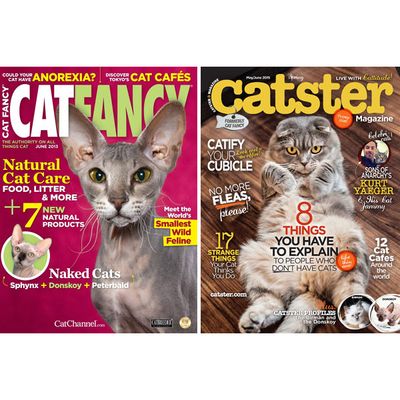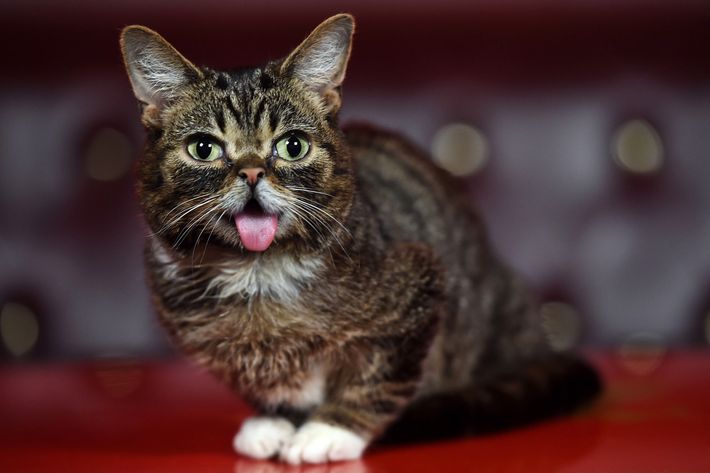
About two weeks ago, longtime Cat Fancy contributor Audrey Pavia got a phone call from the pet magazine’s editor, Susan Logan. Like most of the writers there, Pavia adores Logan — and that made Logan’s bad news all the harder to bear. After 49 years of publication, America’s longest-running cat magazine was getting canceled.
“I was shocked that it was Cat Fancy that went under, just because it’s been around so long and is such a well-loved magazine,” Pavia told me. “It’s like your parents. You always just expect your parents to be there. Then one day, they’re gone.”
The following week, Cat Fancy’s publisher, California-based I-5 Publishing LLC, went public with the news. Of course print magazines disappear all the time these days, but this announcement had a twist: I-5 wasn’t giving up on print. Instead, it was creating two new print magazines to replace Cat Fancy and Dog Fancy, entitled Catster and Dogster. There would be fewer issues per year (Catster one month, Dogster the next, then back to Catster, and so on); but on the other hand, production values were shooting up for the new mags: They’ll have more pages, better binding, and heavier paper stock.
So if this wasn’t a simple death-of-print story, then what happened? With interest in cats at an all-time high (cat content accounts for at least 15 percent of all internet traffic, after all), why was I-5 shutting down the nation’s leading cat monthly?
Extensive interviews with writers and executives there have suggested an answer: Cat lovers killed Cat Fancy. In their defense, they had no idea they were doing it. But in recent years, the nature of cat adoration (and I must offer full disclosure here: I am the parent of two cats) has changed radically. Though Cat Fancy tried to adapt, it never totally broke free from its origins in a different era of cat enthusiasm.
****
To understand the seismic shift in cat culture, you can start by picking apart Cat Fancy’s name. It used to be much more than a whimsical reference to the enjoyment of felines. When the magazine launched in 1965, animal lovers were very familiar with something called “the cat fancy.” The term referred to a connoisseurlike approach to cats: following professional cat shows, maintaining directories of cat breeders, and recognizing the importance of purebred bloodlines.
“Back then, the people who had all the knowledge tended to be the people who were showing cats, breeding cats, everything like that,” said Melissa Kauffman, senior editorial director for I-5. Cat Fancy’s innovation was to take that knowledge — and its attendant attitude toward cats — to a nationwide audience. “They did cover some of the topics that Cat Fancy covers today, but it was more about things like show information.” There were long indexes of breeders, in-depth analyses of different breeds, and impassioned letters from opinionated cat owners (including, in one memorable instance, Ayn Rand).
However, Susan Logan is quick to say the magazine was not snobby. “From the very first [issue], the true scope included mixed-breed cats, feral felines, and even our domestic cats’ wild cousins,” she told me in an email. “Self-described as a magazine for ‘anyone who fancies the cat,’ Cat Fancy from its very first issue in 1965 defined that meaning as a voice devoted to the care, welfare, and adoration of all cats.”
Nevertheless, readers of Cat Fancy in its early decades would likely be aghast at the shape of today’s cat passions. Modern feline icons like Grumpy Cat and Lil Bub are mutts with genetic deformities. They wouldn’t have made it past the front door at a Golden Age cat show. And their many public appearances are filled with fans who would disdain anyone who gets a cat from a breeder rather than a shelter.
“The move today is to adopt cats and give them forever homes,” said Sandy Robins, a regular contributor to Cat Fancy and future columnist for Catster. “Even groups that do rescues for specific breeds, that’s still a rescue focus.”
Logan had long been aware of this cultural shift, and had tried to change Cat Fancy’s focus. Her tenure began in 2003, when the magazine was owned by BowTie Inc., and over the next decade, she did her best to add more articles about rescues and mixed-breed cats.
Then there’s the other massive trend in cat culture that Cat Fancy never totally caught up to: Nowadays, cat enthusiasm is all about laughter and delight. When the internet goes gaga for a piece of cat content, it’s lighthearted, or about cats as an extension of our personalities and lifestyles. It’s a video of a cat massaging another cat or falling into a fish tank. It’s a list of GIFs of cats who “Cannot Even Handle It Right Now.” It’s an advice column about dating a fellow cat person (featuring, of course, lots of GIFs).

By contrast, Cat Fancy and its offshoot website, CatChannel.com (which will remain in operation), are more likely to publish useful-but-staid information about flea and tick products or details about Abyssinians. They have lists and photo essays, of course, but the overall tone remains calm and clinical, like words from a kind veterinarian.
“I’ll be honest: I think there was a bit of an identity crisis,” said Cat Fancy contributor Tamar Arslanian. “I think they were trying to modernize. I think they just started in one position, and it’s hard to commit [to modernizing] and not lose a big part of your audience.”
Believe it or not, that audience did still contain people who wanted no part of the online cat explosion. “Many of those original subscribers, to this day, don’t own a computer,” Robins told me with a laugh. “When one of my cats passed away, I got one or two emails, but I must have got about 40 letters of condolence in the mail. And that was 2009!”
****
Caught in this dilemma, Cat Fancy itself became a kind of mixed breed: part old-school fancier, part new-school rescuer. Sure, there are articles about shelters and feral cats. But traditions have been upheld. As has been true since 1965, every issue has highlighted one to two breeds, both on its cover and in written features. Every issue has contained directories of breeders and listings for shows.
Cat Fancy’s modernization crisis was glaringly obvious to I-5. The company had been formed in early 2013 and swiftly bought BowTie’s array of animal-oriented magazines, including Cat Fancy. BowTie had been crippled by the recession and the overall revenue decline in the magazine industry (and, allegedly, by poor management from owner Norman Ridker), but I-5 saved the day by picking up the periodicals at a cost of roughly $10 million. The magazine’s circulation stood around 160,000 copies a year, a number I-5 hoped to significantly boost.
Given the cultural shifts in cat ownership and perception, it’s no wonder that I-5 became enamored of a relative newcomer to the cat-content world: a website called Catster (as well as its sister site, Dogster). One look at the site and the tonal difference is obvious. The top stories have headlines like “‘Star Wars’ Trailer: See It Remade With Kittens and Puppies” and “We Talk to Audrey Khuner About ‘Hot Guys and Kittens’.” There are also articles about cat behavior and health, but it feels infinitely more of-the-times than Cat Fancy. More important, Catster has found an enormous audience. Right now, a post about how cats show affection has snagged more than 14,000 Facebook likes.
A little over a year after buying Cat Fancy, I-5 bought Catster and Dogster. That purchase was the beginning of the end for Cat Fancy and Dog Fancy. The magazines’ circulation had remained flat under I-5’s tenure, so the time was ripe for a change. Within a few weeks of acquiring the Catster and Dogster websites, the top brass decided to launch print magazines inspired by them. Executives felt that Cat Fancy’s attempts to change course had been admirable, but that the only way to grab the attentions of a new audience and cast off any association with the buttoned-down past was through a fresh start with a brand-new title.
Right away, the new owners agreed with Logan’s concerns about reaching the rescue-minded reader. “Up until a few years ago, [Dog and Cat Fancy] had never had a cat or dog that wasn’t a purebred on the cover,” said I-5 chief sales officer Kim Huey-Steiner. She says Catster will still have breed information, but that it’ll no longer be a major focus. “What you find on the cover of Catster [is] going to be cute cat pictures or irreverent cat pictures, no matter what the breeds are.”
But beyond the covers, what will Catster the magazine be? Much of that won’t be clear until the first issue hits stands in February, but all evidence indicates that it will be extremely photo-oriented, very lighthearted, filled with lists and confessionals, and committed to treating cat ownership as a lifestyle rather than a hobby or a medical burden.
“Catster is for the cat-selfie generation,” Huey-Steiner said. “It’s for people who consider cats an integral part of their social lives. It’s about fun things and knowing that cats rule the roost.” That means lists like “19 Crazy Cat Superstitions” and “Litter-Box Accidents Waiting to Happen,” as well as pieces like “How to Cat-ify Your Cubicle.” There will still be some breed information and veterinary advice, but neither will be a major focus. And then there’s the celebrity aspect.
“We want to capitalize on the role that cats play in the lives of celebrities, whether that’s somebody like a Taylor Swift and how she talks about her cats or someone else,” Huey-Steiner said. “You’d never see that in Cat Fancy.”
I-5 assured me that the total headcount of employees will remain roughly the same, although the editorial leadership is going to change. Susan Logan told me she’s losing her job, but will write for Catster as a freelancer. All of the writers I spoke to have either already had pieces commissioned for Catster or are optimistic that commissions will come soon. They had all come to understand and accept I-5’s logic. As Pavia put it: “You still feel the loss, even if it makes sense on some level.”
Of course, there’s one big question left unanswered: If Catster is supposed to capture the energy of online cat content … then why should anybody bother buying it in print? That’s where I-5’s problems stop being cat-specific. That’s where it has to be like any other magazine publisher: It’s trying to make a visually sumptuous publication that readers will want to hold, not just click.





























